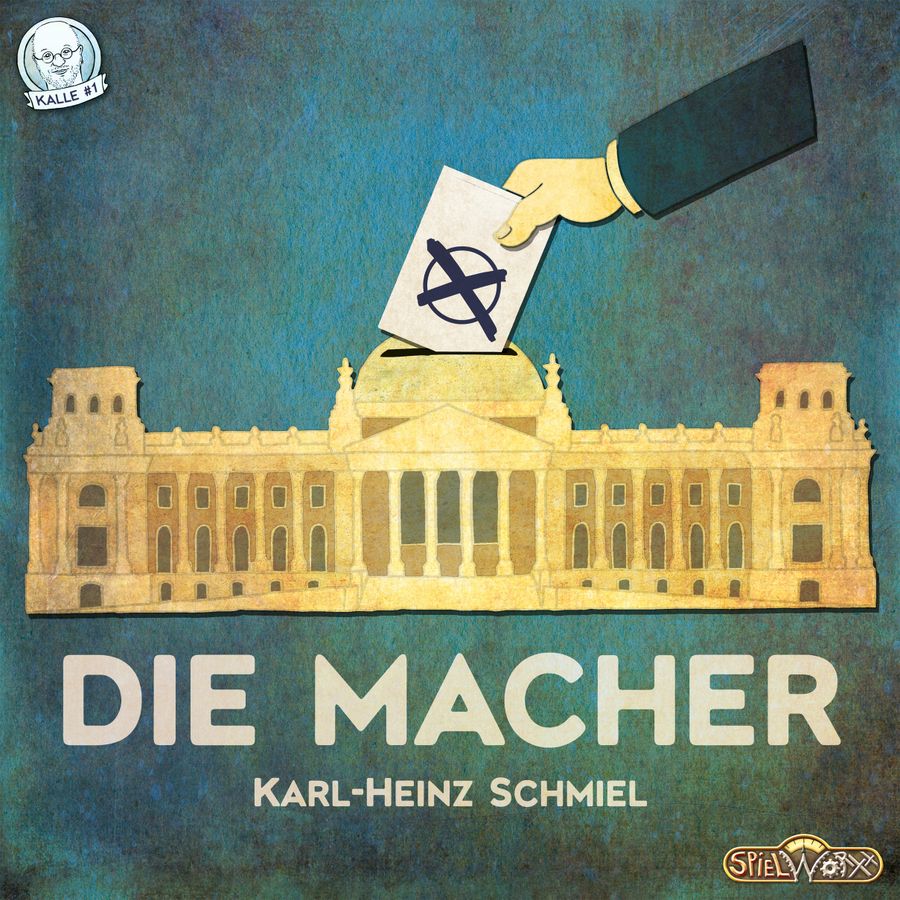Kickstart This! #49: Die Macher

Designer: Karl-Heinz Schmiel (Die Macher, Saint Petersburg Second Edition, Tribune: Primus Inter Pares)
Artists: Marcus Gschwendtner (Die Macher), Harald Lieske (Amerigo, Arkwright, Aton, Bohnanza, Carcassonne: South Seas, The Castles of Burgundy, The Castles of Burgundy: The Card Game, Catan, Dominion, Dominion: Intrigue, Fabled Fruit, Friday, Gentes, Glen More, La Granja, In the Year of the Dragon, Kraftwagen, Las Vegas, Macao, Die Macher, Notre Dame, Power Grid, Power Grid Deluxe: Europe/North America, Puerto Rico, San Juan Second Edition, Smash Up: Monster Smash, The Speicherstadt, Vikings, Washington’s War, Witches’ Brew)
Publisher: Spielworxx (1989: Dawn of Freedom, Arkwright, Gentes, La Granja, Die Macher, Virgin Queen, Washington’s War), Indie Game Studio (Aftershock: San Francisco & Venice, Egizia: Shifting Sands, Survive: Escape From Atlantis!)
Genre/Mechanisms: area control, auction/bidding, dice rolling, economic, hand management, simultaneous action selection
Funding Status: At the time of this posting, Die Macher: Limited Edition is already fully-funded. In fact, pledges currently total more than 7.5x the initial funding goal.
Player Count: 3-5
Solo Mode: no
Complexity: heavy
Risk: medium-high
What It’s About: Players are in charge of national political parties during seven sequential political races in different regions of Germany.
How It Works: Die Macher is played over 4 rounds, with each round consisting of 9 Phases sub-divided into 3 Segments. The Preparations Segment contains the phases to Determine the Start Player and (Make) Changes to the Party Programs. To determine start player, all players bid secretly & simultaneously, using up to the amount of money they currently own. A tie is broken with a second bidding process between the two tied players. Players then make Changes to their Party Programs beginning with the first player and continuing clockwise. Players can either take one party program card from the draw stack and then one face-up card from the display into their hand; or they can discard all cards from the display to the discard stack, draw new cards and refill the display, and then take 1 face-up card from the display into their hand. Afterwards, they may swap up to 2 party programs in front of them with their hand, then discard down to 1 card.
The Deployment Segment is comprised of Securing Media Influence, Organizing Party Rallies, and Sending in the Shadow Cabinet. To Secure Media Influence, players take turns buying one media marker for 5,000 Euros, beginning with the starting player. Players continue buying one media marker per action until all players have passed. Then, beginning with the starting player, each player may Organize Party Rallies once; the cost is a sliding scale and becomes more expensive the more rallies a player chooses to organize in their one action. Finally, players can send in members of their Shadow Cabinet to help influence the vote; each player has 5 members, and each may be Sent once per game.
The final Changes Segment consists of Actions of the Shadow Cabinet, Media Influence, Auctioning Off of Polls, and Evaluation of Votes & Federal State Election. The Actions of the Shadow Cabinet is a simultaneous revel of the members placed during Sending in the Shadow Cabinet, and then an evaluation of those member’s effects. Media Influence actions begin with the federal state holding election at the end of the round and proceeds clockwise; each player that influences the media in a given federal state may shift one popular opinion there. Next, the player with the most votes in this federal state is the auctioneer; that player hosts bids to purchase auction polls in each federal state, thereby changing the trends of parties or raising their own party base. The final phase, the Evaluation of Votes & Federal State Election, lasts the longest and is comprise of 4 of its own parts: Relocating Votes, in which players can transform their party rallies into votes; Determining Effects of the Federal State Election, in which players receive victory points for their votes and determine the winner of the election; Pay Money, where players receive more state money and donations to further finance their political work (in all but the 4th round); and finally, Preparing for the Next Game Round, requiring a bit of clean-up and re-setting (also skipped in the 4th round).
At the end of the game, players score points for their media markers, the size of their party base, and for their leftover money (the player with the most money scores 6 points, the second-most scores 3, and everyone else scores 0). The player with the highest total points is the winner!
Comparisons: Originally released in 1986, Die Macher has become a classic in its own right, as well as one of the most famous early heavy Euros. Haas games ran a Kickstarter early in the year for a project called Zoocracy that plays like a simpler, lighter version of Die Macher, with anthropomorphic zoo animal art courtesy of The Mico. Some other well-known games that incorporate various combinations of economics, politics, and negotiation include 1960: The Making of a President, Battlestar Galactica: The Board Game, A Game of Thrones: The Board Game, Lisboa, Trajan, Twilight Imperium, and Twilight Struggle.
What Should I Pledge?:
$69 Die Macher: Limited Edition: that’s the one!
Add-Ons:
None.
KS Exclusives:
Likely the whole project. There are currently no plans for Die Macher: Limited Edition to have a retail release. Also, there have been some tweaks and re-designing implemented by the game’s original designer, Karl-Heinz Schmiel, for this edition. It also features all-new art by Harald Lieske.
All-In Total: In the continental U.S. you’re looking at $69 for the game and $10 in shipping for a total of $79.
Die Macher completes its Kickstarter on Thursday, July 11th and tentatively ships in November 2019.